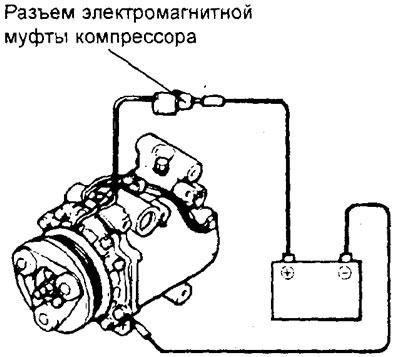Note: the procedures for checking the engine overspeed at idle, adjusting the tension of the accessory drive belt and replacing the cabin filter are given in chapter "Maintenance and general inspection and adjustment procedures".
Checking the refrigerant level through the sight glass
1. Start the engine.
2. Turn on the air conditioner and set the temperature control switch to "MAX COOL" (maximum cooling).
3. Keep the engine running at 1500 rpm.
4. Check the amount of refrigerant in the air conditioning system through the sight glass for the number of bubbles.
A) The appearance of foam indicates a very low level of refrigerant (lack of refrigerant).
b) The absence of bubbles indicates an excess of refrigerant.

5. If the amount of refrigerant does not correspond to the optimal state, then recharge or recover the refrigerant, and then check the refrigerant level again.
The amount of refrigerant - 550 + 20 g
Caution: Use a low pressure service valve when carrying out work.
Note:
- If there is not enough refrigerant in the system, then add refrigerant to the system until no bubbles are visible from the sight glass, then add another 100 g of refrigerant.
- If there is an excess of refrigerant in the system, then pump out the refrigerant until bubbles appear in the sight glass, then add another 100 g of refrigerant.
Checking the electromagnetic clutch of the compressor
1. Disconnect the compressor magnetic clutch connector.
2. Connect a wire from the positive plug of the storage battery directly to a conclusion of a socket of electromagnetic, couplings.
3. If the clutch is working, you will hear "click" her operation.
4. If the anchor and pulley do not come into contact ("click" no actuation), then the magnetic clutch is faulty.

Checking the refrigerant pressure sensor
1. Install the gauge manifold on the high pressure service valve.
2. Start the engine and turn on the air conditioner.
3. Check that the signal voltage of the sensor in relation to the refrigerant pressure between the output "2" sensor and "weight" changes as shown in the graph.
Note: the permissible deviation from the value on the graph is not more than 5%.


Relay test
Note: checking the control relay for electric fans is given in chapter "Cooling system".
1. Checking the heater fan motor relay.
A) Check for continuity between terminals "1" - "3" relay when no power is applied.
b) Bring the power (battery voltage) to conclusions "1" (+) And "3" (-) and check for a closed circuit between the terminals "4" - "5" relay.

2. Checking the relay of the electromagnetic clutch of the air conditioning compressor.
A) Check for continuity between terminals "2" - "3" relay when no power is applied.
b) Bring the power (battery voltage) to conclusions "3" (+) And "2" (-) and check for a closed circuit between relay terminals 1-4.

